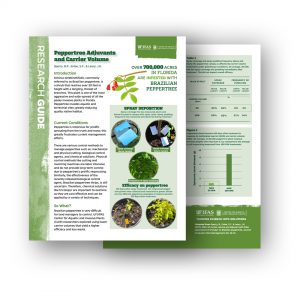Research biologist Ben Sperry, alongside professors Stephen Enloe and James Leary, examined the impact of carrier volume on Brazilian peppertree (Schinus terebinthifolia) leaf treatments. The term ‘carrier volume’ refers to the concentration of herbicide within a treatment solution. Professional applicators and biologists calculate the appropriate carrier volume for each treatment they do. Sperry, Enloe, and Leary found that in almost all cases, Brazilian peppertree resprouted more following the 100 gallons per acre (GPA) treatment. This result indicates that peppertree management may be more effective under lower carrier volumes (such as 20 GPA), resulting in less herbicide runoff during treatments.
So What?
Brazilian peppertree is very difficult for land managers to control. This plant is notorious for prolific sprouting after treatments, which greatly frustrates land managers. In this experiment, UF/IFAS CAIP researchers found that reducing carrier volume appears to be more precise and more effective, resulting in less herbicide runoff.
To read or download this research guide, visit UF/IFAS CAIP’s Publications.
This research guide highlights:
- Brazilian peppertree is one of the most aggressive and widespread invasive plants, which infests over 700,000 acres in Florida.
- Mechanical control methods, such as physical cutting, are labor-intensive and don’t provide long-term control. The effectiveness of biological controls (Brazilian peppertree thrips) is currently being examined. Therefore, chemical solutions are important to examine as they are cost-effective and can be applied in a variety of ways.
- UF/IFAS CAIP researchers evaluated spray coverage and puddling frequency immediately after treatments and plant biomass 180 days after treatment. These measurements allowed the researchers to evaluate how peppertree responds to 20 GPA treatments versus 100 GPA. They found that following treatment, the higher carrier volume (100 GPA) resulted in more re-sprouting and plant growth than the lower carrier volume (20 GPA).
What is a Research Guide?
The UF/IFAS Center for Aquatic and Invasive Plants (CAIP) is an internationally recognized multidisciplinary research, teaching, and extension unit known for having the most relevant information on invasive plant management. This one-of-a-kind Center focuses on developing and disseminating strategies for addressing the impact of invasive plants.
To share their findings, CAIP researchers and the communications team collaborate to translate scientific journal articles into simple, easy-to-understand research guides. These one-page research guides are simplified summaries about research projects happening at the Center. They are created to assist plant industry professionals and the public understand new scientific information quickly and easily.
Follow UF/IFAS CAIP on Facebook, Instagram, and Twitter. Read more blogs like this one on the UF/IFAS CAIP blog.
UF/IFAS Center for Aquatic and Invasive Plants. Turning Science Into Solutions.
 0
0

